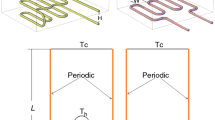Abstract
This paper presents the simulation models of the plate-fin, air-to-water (or water vapour) heat exchangers usedas air-heating or air-cooling and dehumidifying coils in the HVAC (Heating, Ventilation and Air-Conditioning) systems. The thermal models are used to calculate the heat exchange between distributing air and coil pipes and outlet temperatures of air and heat or chilled fluid. The aerodynamic models are used toaccount for the pressure drop of the air crossing the coil tubes. They can also be used to optimize the structures of such coils. The models are based on principal laws of heat and mass conservation and fluid mechanics. They are transparent and easy to use.
In our work, a coil is considered as an assembly of numbers of basic elements in which all the state variables are unique. Therefore we can conveniently simulate the coils with different structures and different geometric parameters. Two modular programs TRNSYS (Transient System Simulation) and ESACAP are utilized as supporting softwares which make the programming and simulation greatly simplified. The coil elements and a real coil were simulated. The results were compared with the data offered by the manufacturer (company SOFICA) and also with those obtained using critical methods such as NTU method, etc. and good agreement is attained.
Similar content being viewed by others
References
D.R. Clark, C.W. Hurley and C.R. Hill, “Dynamic Modfor HVAC System Components,”ASHRAEtion, 85, Part 1b, pp.737–750, (1979).
ASHRAE 1988 Equipment Handbook, Chapter 9.
S.P. Oskarsson, K.I. Kraray and S. Lin, “Evaporator Models for Operation withDry, Wet and Frosted Finned Surfaces, Part 1,”ASHRAE Transactions, 96, Part 1, (1990).
S.P. Oskarsson, K.I. Krakav and S. Lin, “Evaporator Models for Operation with Dry, Wet and Frosted Finned Surfaces, Part2,”ASHRAE Transactions, 96, Part1, pp.381–392, (1990).
J.L. ARMAND,N.MOLLE, “Caractdrisation des Batteries &Ailettes au Moyen duLogiciel CANUT Application à la Simulation des Performances,” Revue Gknkrale de Thermique,mai, (1991).
P.A. Domanski, “Simulation of an Evaporator With Nonuniform One-dimensional Air Distribution,”ASHRAE Transactions, 92, Part 1,
W.M. ROHSENOW, “Handbook of Heat Transfer,” Section Mc Graw-Hill, (1973).
R. CADIERGUES, “Propriété de l’air Humid et de l’eau, Justification de Nouveaux Choix,” Promoclim E. Tome9E N o 1, janvier, (1978).
R. CORDIER, “Dimensionnement des Echangeurs à Condensation Pourles Générateurs de Chaleurà Gaz Destinés au Chauffage Collectif,” RevueGénérale de Thermique,février, (1987).
C. FAYE, P.E. MCQUISTON, “Finned Tube Heat Exchangers: State of the art for the air side,”ASHRAE Transactions,87, Part 1, (1981).
I.F. IDEL’CIK, Traduit par Mme. M.Meury, “Memento des Pertes de Charge,” Collection de la Direction des Etudes et Recherches Eyrolles, (1979). TRNSYS: A Transient Simulation Program Solar Energy Laboratory, University of Wisconsin-Madison, (1988). Poul Stangerup The Simulation ELECTRONIKCENTRALEN, DENMARK, (1987).
Author information
Authors and Affiliations
Rights and permissions
About this article
Cite this article
Wang, Z., Krauss, G. Dynamic models of heating and cooling coils with one-dimensional air distribution. J. of Therm Sci 2, 126–134 (1993). https://doi.org/10.1007/BF02718268
Received:
Issue Date:
DOI: https://doi.org/10.1007/BF02718268




